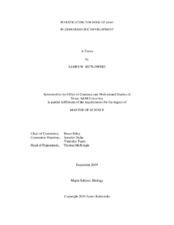| dc.description.abstract | Preliminary data gathered by our lab suggests a requirement for lactate in the developing inner ear of zebrafish embryos, implicating the action of the Warburg effect in otic development. A potential regulator of this Warburg effect is the transcription factor foxm1, which may also be mediating the Wnt and Fgf signals known to pattern the inner ear. Studies of the effects of foxm1 were performed with the heat-shock transgene hs:foxm1, morpholino oligomers for foxm1 knockdown, and a TALEN-induced foxm1 knockout line. In transgenic hs:foxm1 embryos the only observed effect of heat shocks was an increase foxm1 mRNA abundance. Regardless of heat shock time point or BIO, IWR-1, or 2DG treatment status, heat shocks did not cause changes in morphology or gene expression. Several hypothetical explanations for the transgene’s ineffectiveness were tested, with new experiments planned to continue the exploration of the effects of foxm1 overexpression. Knockdown of foxm1 by morpholino oligomers resulted in significant dorsalization, severely reduced Wnt signaling, altered Fgf target gene expression, and reduced pgk1 expression. These results support the hypothesized role of foxm1 as a Warburg regulator and a mediator of Wnt and Fgf signaling. A foxm1 knockout allele was generated with the use of TALENs, and a foxm1 knockout line was created. For unknown reasons, this knockout mutation was not observed to have any effect on morphology or gene expression.
To test whether this was due to an early rescue effect, an attempt was made to generate maternal-zygotic mutants, but due to breeding issues the phenotype of MZ foxm1 mutants remains unknown. Further experiments, possibly including the creation of another foxm1 knockout allele, will be necessary to explore the true effects of foxm1 knockout. It is our hypothesis that the foxm1 knockout phenotype, in the absence of any genetic compensation effects, will resemble the foxm1 morphant phenotype. | en |


